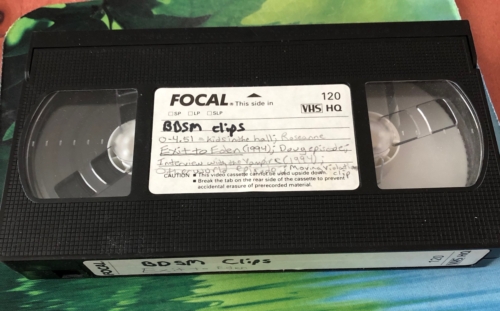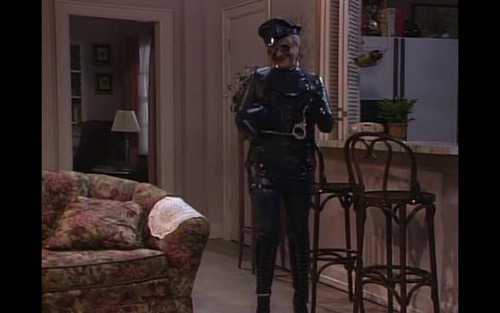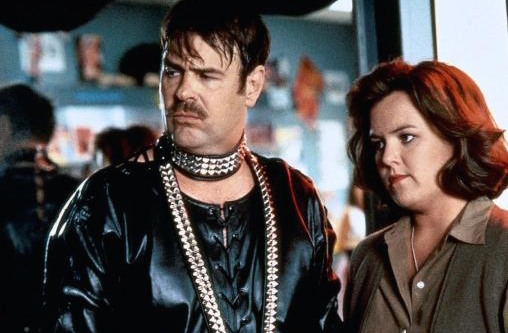Growing Up Femdom: Mass Media Reflections I
By TammyJo Eckhart, PhD
When I was a little girl, I was already dominant leaning. TV shows, books, movies, and even the stories I made up, that were girl-led, woman-led, or populated by Amazon-like societies, were filtered by my mind, so I only remember what strongly appealed to me. Today I’m a published kink author who has a PhD minor in the History of Gender and Sexuality. I know that I will still filter what I see and hear through a personal lens, but I have the tools to try to be objective. I’m glad that I’m finally able to write about some of the mainstream images of kink I remember liking when I first encountered them. I’m going to talk about some of the TV shows, TV clips, and TV movies from the tape you see a photo of, though this is an artificial limit for this post and not even close to everything I could write about. It has been over two decades since I last recorded on this tape. Do I think these are still examples of woman-led relationships, or do they play into stereotypes that harm women, relationships, and kink in general?
I’m going to go in the order of recordings on this VHS tape and only write about woman-led representations. Two of the recorded shows were not like this, just kinky in general. Six other pieces recorded did have femdom-like dynamics. The range on this one tape is wide, from a kids’ cartoon to horror. Most of these can be found and watched today through various online or streaming services, in case you want to check them out for yourself.
The Roseanne show was one I grew up watching regularly. While Darlene and David arguably had a budding woman-led dynamic, the clearest kink-related episode was “Body by Jake,” episode 23 of season 6, which aired on May 10, 1994. Half of the episode revolves around Beverly, Rosanne’s domineering mother. After Beverly breaks her hip during sex, she and Rosanne have a talk about sex, which for the older woman has never been about pleasure, just about duty, and best done during “commercials.” When Roseanne urges her mother to try things that she might like, that is a hopeful, pro-feminism message. Then, in the final scene after some credits, we are taken into Beverly’s apartment. The dialogue between Beverly and her boyfriend Jake is honest and natural sounding. It isn’t until Beverly leaves the other room and comes into the front room in a stereotypical dominatrix costume carrying a riding crop that the laugh track starts in. For me, that was not a funny moment; it was reassuring. Even though Beverly was older, she could find something that both of them seemed to enjoy.
Exit to Eden is one of my favorite kinky comedy movies. When it came out in NYC in 1994, I was the host of the Apple Munch, and we got as many folks as we could get together and went to the premiere dressed in appropriate attire. The movie is based on Ann Rice’s novel Exit to Eden, which came out in 1985. I had read the novel and was not pleased by it, because I felt it excused rape and ended with the rejection of kink for het relationships. I had heard that the movie was not going to do those two things, so I had hope. Mainstream test audiences didn’t know how to react to the scenes on the island, so the studio kept increasing the amount of time that Rosie O’Donnell (playing Sheila/Lucy) and Dan Aykroyd (playing Fred) were on the screen. A lot of kinky folks online expressed dismay toward the comedic elements, but I found that the character arc of Sheila, who is fairly open minded to begin with and then develops a relationship with one of the submissive attendees, Tommy, played by Sean O’Bryan, is presented in a positive fashion.
Compared to the common portrayal of BDSM as crime, crime-adjacent, or at least tragic, I still think this is a wonderful movie to just enjoy. In fact, if the comedic elements really annoy you, just fast-forward through them. The movie undid some of the aspects of the novel’s plot and characters that I find highly triggering even today, but there are some borderline consent issues that still pop up that reflect either therapy (the beating scene when Elliot, played by Paul Mercurio, is in the room of Lisa, played by Dana Delany) or the norm in het relationships (when Elliot surprises Lisa with oral sex in her bed). Yes, the film still shows Lisa, the head of the island, to be an abuse survivor, but as one myself, I can say that survivors are not rare in the BDSM community. At least in the movie version, she realizes that she can be dominant and a fulfilled woman at the same time. For me, that message of empowerment through kink is important and rare. I feel that the relationships between Lisa and Elliot as well as Sheila and Tommy were realistic; I could believe those people would make a connection.
This next TV show episode might freak a few out, because it is from a kid’s show called Doug, an animated show which aired from 1991-1994. The episode is called “Doug is Slave for a Day” and involves a common sit-com set-up of one sibling blackmailing the other into being their “slave” in order to avoid parents learning something horrible. In fact, this trope is so common in comedy that Doug’s best friend Skeeter takes the news of Doug’s predicament as normal. This was the second episode of the third season of Doug and focused on the main character and his elder sister, Judy. One has to wonder how long Judy has been planning to enslave someone, considering she had this massage contract that she has Doug blindly sign. While there is certainly nothing sexy in this show, if I had seen this as a kid myself, it would have had a huge impact on reassuring me that my desires weren’t utterly abnormal. Plus, Judy has red hair, so I could certainly have imagined myself as a nicer version of her. If I had kids today, I could see using this as a means to talk about honesty and informed consent, neither of which should be exclusive to BDSM, should they? Of course, since Doug is the main character, he eventually turns the tables on his captor.
I was always a huge science fiction and fantasy fan. The short run series Otherworld had everything I wanted: a strong family, dimension crossing, weird societies of the week, and two strong female characters in mother Judy Sterling, played by Gretchen Corbett, and daughter Gina, played by Jonna Lee. The episode “I Am Woman, Hear Me Roar” aired on March 2, 1985, and I watched it live as well as a half a dozen times since. I didn’t know at the time that it was the last episode of the series, but at least that means it didn’t kill the series; that fate had already been decided. The story is a reversal tale where a matriarchy is set up in one of the zones that exist on Thel, which may be an alternate Earth or simply another planet with humanoid lifeforms. The zone, called Adore, is far from other zones. The names of houses, apartments, and costumes are stereotypically feminine. The family ends up in a conservative part of town where having a husband and sons is frowned upon, even though it is not illegal. The common tropes about matriarchies and slavery are here. The father’s ability to read is shocking, and women don’t want men to speak, but there are different conservative rules in play, too. The mother cannot even enter a grocery store, because the electronic door will not allow women to do that sort of domestic work, and the men cannot remove their shirts in public places. The shirt thing may be a commentary on the ridiculous double standards of dress in America, but the idea of using technology to keep one sex/gender down is actually terrifying. The family tries to adjust, but teenage son Trace struggles the most and ends up arrested and put on the auction block, where his family must convince neighbors to buy him back. I remember that the show thrilled me as a 15-year-old; today it is still amusing, but I have to wonder how many of the reversals and extremes were simply commentaries on life in 1984 and 1985, when conservatives held even more power than they do today. Author John Kenneth Muir has written about this very show, and he seems to think each episode was quite purposefully tackling contemporary issues and drawing from other classic science fiction works.
Moving Violations is a 1985 comedy film about corrupt cops trying to scam people who have traffic violations out of their cars. At one point, not far from the end of the movie, the ragtag group of remedial drivers tracks down Judge Nedra Henderson (played by Sally Kellerman) and Deputy Hank Halik (played by James Keach) as they are meeting up for some kinky games with the judge on top. The movie itself completely plays the scene of the kinky encounter for laughs, as the corrupt law enforcement acts are dressed in stereotypical kinky outfits and tossing back and forth lines like “Are you going to be a good boy?” and “Yes, Mommy.” If you pay attention, the two involved are enjoying themselves so much that they don’t notice another person falling into bed with them at one point while trying to retrieve a ledger that will prove their corruption. What I like about the scene, other than the obvious affection between the two in bed, is that the other cop who has discovered the corruption isn’t fazed by their activities; she is only interested in the fact that they are using their authority outside of the bedroom to harm others. Even though their outfits draw unwanted attention during a chase that follows, it is clear that they are equals in their scam and in their desires. That’s a positive message underneath the comedy.
Look What’s Happened to Rosemary’s Baby was a 1976 TV sequel to Rosemary’s Baby (1968). The movie is not good and doesn’t make a lot of sense. Why was a clip on my VHS tape? There was a brief scene of Rosemary (not the one from the first film), who has used magic to capture a man to force him to mate with her. I guess when I recorded this the fact of a woman having power over a man was powerful to see, and I must have seen it on television when I was a kid in order to know to tape it. Using magic, drugs, or violence to get someone to have sex with you is not kink, and there isn’t an excuse here of it being a sibling “enslavement” as in Doug. Today I wouldn’t call this scene even kink-adjacent, just part of a horror movie where sex is dangerous.
This trip down memory lane showed me how good my memory is and is not. Sadly, I didn’t get the title recorded for each clip on the VHS tape, so a few times I had to try to figure out what I was rewatching. I can say that most of what I considered femdom in those shows still fits that category across different genres and target audiences. It is often played for comedy or used to comment on patriarchy – heck, I do that in my own writing – but to a child or a young person trying to see herself in the world around her, these were important and powerful examples of what could be. I’m glad to say that I could see through the stereotypes and tropes and create a more egalitarian woman-led household as an adult.







